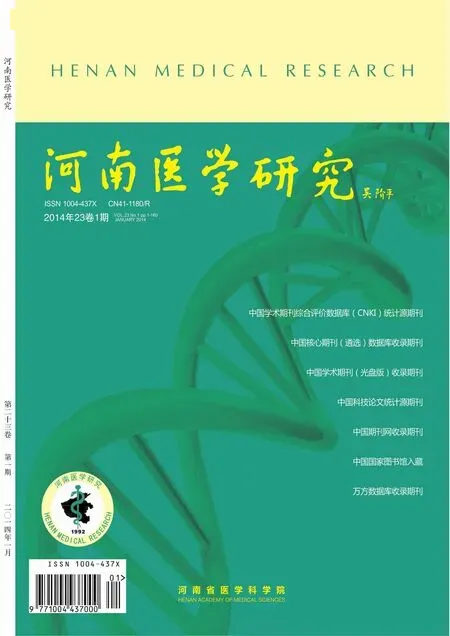三陰性乳腺癌相關基因的研究進展
李曉旭,高艷麗,李孟圈,許 瀚
(1.鄭州大學第一附屬醫院乳腺外科 河南鄭州 450052;2.鄭州市衛生學校藥理教研室 河南鄭州 450005)
乳腺癌是女性常見的惡性腫瘤之一,是一種異質性較高的惡性腫瘤。Perou等[1]通過采用 cDNA微陣列技術將乳腺癌分成導管A型、導管B型、人表皮生長因子受體(Her-2)過表達型和基底樣(Basal-like)型。Bryan等[2]首次明確提出了三陰性乳腺癌(triplenegative breast cancer,TNBC)的概念,即雌激素受體(estrogen receptor,ER)、孕激素受體(prog-esterone receptor,PR)和Her-2表達均為陰性的一種特殊類型的乳腺癌。近年來,隨著醫療水平的不斷提高,乳腺癌相關基因的研究越來越深入,基因表型分析領域的研究成果為TNBC的治療和預后評估提供了很大幫助,本文將對TNBC相關基因的研究進展進行綜述。
1 TNBC的特點及基因分型
1.1 TNBC的特點 TNBC約占所有乳腺癌的15%。侵襲性較強,分化程度較低,常有家族史[3]。Carey等[4]研究發現,50歲以下美國非洲裔婦女發病率可高達39%。另有研究顯示,TNBC患者中肥胖者占49.6%,非TNBC女性中肥胖者僅占35.8%,推測肥胖女性更易患TNBC[5]。TNBC預后較差,復發及遠處轉移發生率較高。
1.2 TNBC的基因分型 按基因表型將TNBC分為6型:基底樣細胞樣型1(basal-like1,BL1),基底樣細胞樣型 2(basal-like 2,BL2),間質型(mesenchymal,M),免疫調節型(immunomod-ulatory,IM),腔上皮雄激素受體型(luminal and rogen receptor,LAR)和間質干細胞樣型(mesenchymal stem-like,MSL)。BL1型和BL2型多高表達DNA損傷修復基因;M型和MSL型多為間質表現,大量免疫細胞浸潤和低表達細胞-細胞連接蛋白;IM多高表達型免疫應答基因;LAR型則表達雄激素受體。6種分型TNBC的無復發生存(RFS)并不一致[6]。通過對TNBC進行基因分型,可以幫助判斷TNBC的預后和尋找靶點,對TNBC的個體化治療有重要意義。
2 TNBC相關基因
隨著研究水平的提高,對于腫瘤發生機制的研究也逐步深入,TNBC相關基因逐漸被許多研究證實,為TNBC發生機制的闡明、指導治療提供了重要價值。Wen等[7]分析51名TNBC患者的基因表達,45個TNBC復發和轉移相關基因被篩選出來。Teschendorff等[8]首次報道了可以預測ER陰性乳腺癌患者預后的7個相關基因,并開發了7個基因表達分類預后工具。TNBC大多表達肌上皮標志物和細胞角質蛋白等,相較于非 TNBC,c-Kit、p53、Her-1(EGFR)等在 TNBC 中高度表達[9]。目前,研究較多的幾個主要TNBC相關基因是 P53、CK5/6、BRCA1、Ki67、EGFR 等。
2.1 p53 p53是迄今為止發現的與腫瘤高度相關的基因之一,是具有廣泛抑癌作用的重要基因,可抑制細胞增殖,促進細胞分化、凋亡和監測DNA損傷,TNBC中高度表達可至85%,且常發生 p53突變[10],p53突變后并不會阻止細胞增殖,可以導致異常的有絲分裂以及細胞死亡,從而致使腫瘤產生,研究發現MDM2是p53通路中重要的負反饋調節因子,因此p53是TNBC個體化治療的重要突破口之一。
2.2 CK5/6 CK5/6為基底細胞型細胞角蛋白,在乳腺組織的腺中間細胞、定向干細胞、肌上皮中間細胞表達,在肌上皮終端細胞和腺上皮終端細胞則不表達。有研究認為,只憑借基底型CK在腫瘤細胞中表達就可以界定為basal-like型乳腺癌,而不需要其他的標志[11]。鄧再興等[12]研究發現 TNBC 中 CK5/6表達率達80.8%,再次證明basal-like型與TNBC的高度相關性,研究發現CK5/6陽性的TNBC的TNM分期較高、淋巴結轉移率較高,而這些都與臨床預后關系密切。
2.3 BRCA1 BRCA1定位于人類第17號染色體,是G/M期關鍵點調控因子,可通過激活Chkl激酶從而誘導阻滯G/M期修復損傷的DNA,還可控制細胞周期G/M期順利進行中起重要作用的兩種蛋白的表達來調節細胞周期,重新塑造染色質,并可調控基因轉錄。TNBC常伴有BRCA1突變,大約占30%,而TNBC在BRCA1突變的乳腺中所占比例高達90%,兩者在表形特征及分子水平上有很多相似之處[13]。BRCA1是重要的抑癌基因,BRCA1基因突變使與其功能相關的基因序列發生變化,抑制腫瘤的功能喪失,致使乳腺癌發生[14]。因此BRCA1可以作為生物標記蛋白輔助診斷及治療TNBC。
2.4 Ki67 Ki67是細胞增殖高相關的核抗原,隨著細胞周期變化其抗原表達也發生變化。Gerdes等[15]研究發現 Ki67表達于 G1、S、G2、M 期,不表達于 G0期,研究還發現Ki67微量表達于G1晚期/S早期,并聚集于S期,并且明顯高表達于后半期,在有絲分裂的后期迅速降解或者抗原決定簇失去,所以很多學者認為Ki67可以有效的評價腫瘤細胞增值的活性[16],TNBC中Ki67的表達較癌旁周圍正常組織明顯升高[17-19],所以Ki67的表達對研究 TNBC的生物學特性、評價其危害性具有很重要的意義。
2.5 EGFR EGFR是Her家族成員,是原癌基因cerbB1表達產物,也被稱作Her-1、ErbB1,位于細胞膜表面,通過與配體結合而激活,進而激活位于細胞內激酶通路,從而誘導細胞增殖,如發生突變或過表達都將導致腫瘤的發生。許多研究表明TNBC中EGFR過表達[20-22]。因此,在TNBC缺乏內分泌治療和Her-2受體靶向治療的情況下,EGFR信號通路靶向治療的研究可能會成為TNBC個體化治療新的突破。
3 TNBC基因靶向治療
TNBC由于ER、PR及Her-2表達陰性,相對于其他乳腺癌缺乏特異治療靶點。然而,EGFR在TNBC中過表達,針對該靶點的藥物可能對TNBC有效,如抗EGFR抗體(西妥昔單抗)。Gholam等[23]采用西妥昔單抗聯合紫杉醇治療TNBC皮膚轉移患者,療效顯著。鉑類藥物在TNBC治療中有特殊作用,聯合西妥昔單抗治療乳腺癌亦有一定效果[24]。達沙替尼是一個口服多靶點抑制劑,Finn等[25]研究表明,TNBC細胞對達沙替尼具有高度敏感性。最近研究表明TNBC中CD109表達明顯增強,可能成為一個潛在的藥物靶點[26]。
4 結語
TNBC是一種侵襲性較強、預后較差、復發和轉移較高的乳腺癌亞型,由于TNBC患者雌孕激素及Her-2受體均為陰性,相對缺乏藥物治療靶點,目前尚無明確的治療指南和個體化治療。近年來,對TNBC相關基因的研究越來越多,許多TNBC相關基因逐漸被發現。相信通過更深入的研究,能夠探索出更多TNBC靶向治療的潛在靶點,為該類乳腺癌患者的治療帶來希望。
[1]Perou C M,Sorlie T,Eisen M B,et al.Molecular portraits of human breast tumours[J].Nature,2000 ,406(6797):747-752.
[2]Bryan B B,Schnitt S J,Collins L C.Ductl carcinoma in situ with basal-like phenotype:a possible precursor to invasive basal-like breast cancer[J].Mod Pathol,2006,19(5):617.
[3]Dent R,Trudeau M,Pritchard K I,et al.Triple negative breast cancer:clinical features and patterns of recurrence[J].Clin Cancer Res,2007,13(15Pt1):4429-4434.
[4]Carey L A,Perou C M,Livasy C A,et al.Race,breast cancer subtypes,and survival in the Carolina Breast Cancer Study[J].JAMA,2006,295(21):2492-2502.
[5]Vona-Davis L,Rose D P,Hazard H,et al.Triple-negative breast cancer and obesity in a rural Appalachian population[J].Cancer Epidemiol Biomarkers Prev,2008,17(12):3319-3324.
[6]Lehmann B D,Bauer J A,Chen X,et al.Identification of human triple-negative breast cancer subtypes and preclinical models for selection of targeted therapies[J].J Clin Invest,2011,121(7):2750-2767.
[7]Kuo W H,Chang Y Y,Lai L C,et al.Molecular characteristics and metastasis predictor genes of triple-negative breast cancer:a clinical study of triple-negative breast carcinomas[J].PLoS One,2012,7(9):e45831.
[8]Teschendorff A E,Miremadi A,Pinder S E,et al.An immune response gene expression module identifies a good prognosis sub-type in estrogen receptor negative breast cancer[J].Genome Biol,2007,8(8):R157.
[9]Cleator S,Heller W,Coombes R C.Triple-negative breast canser:Therapeutic options[J].Lancet Oncol,2007,8(3):235.
[10]Korsching E,Packeisen J,Agelopoulos K,et al.Cytogenetical 2 treations and cytokeratin expression patterns in breast cancer:in tegrating a new model of breast differentiation into cytogenetic pathways of breast carcinogenesis[J].Lab Invest,2002,82(11):1525-1533.
[11]Rakha E A,EI-Sayed M E,Green A R,et al.Breast carcinoma with basal differentiation:a proposal for pathology definition based on basal cytokeratin expression[J].Histopathology,2007,50(4):434-438.
[12]鄧再興,俞文菊,朱凱.乳腺癌組織CK5/6與EGFR表達及其臨床意義的研究[J].中華腫瘤防治雜志,2008,15(19):1477-1480.
[13]Friedman L S,Ostermeyer E A,Lynch E D,et al.The search for BRCA1[J].Cancer Res,1994,54(24):6374-6382.
[14]Uyei A,Peterson S K,Erlichman J,et al.Association between clinical characteristics and risk-reduction interventions in women who underwent BRCA1 and BRCA2 testing:a single-institution study[J].Cancer,2006,107(12):2745-2751.
[15]Dowsett M,Smith I E,Ebbs S R,et al.Prognostic value of Ki67 expression after short-term presurgical endocrine therapy for primary breast cancer[J].J Natl Cancer Inst,2007,99(13):167-170.
[16]Xu T,Zhu Y,Xiong Y,et al.Ki67 suppresses tumorigenicity and regulates G1/S transition of human hepatocellular carcinoma cells[J].Hepatology,2009,50(1):113-121.
[17]Bauer K R,Brown M,Cress R D.Descriptive analysis of estrogen receptor(ER)-negative,progesterone receptor(PR)-negative,and HER2-negative invasive breast cancer,the so-called triple-negative phenotype:a population-based study from the California Cancer Registry[J].Cancer,2007,109(9):1721-1728.
[18]李梅,姚樂,惠起源.Livin、Ki-67蛋白在胃癌中的表達及意義[J].現代腫瘤醫學,2011,19(2):302-304.
[19]徐文,李景賀,金方方,等.腎細胞癌E-cad和 Ki-67的表達及臨床意義[J].現代腫瘤醫學,2010,18(9):1774-1777.
[20]Nielsen T O,Hsu F D,Jensen K,et al.Immanohistochemical and clinical characterization of the basal-like subtype of invasive breast carcinoma[J].Clin Cancer Res,2004,10(16):5367-5374.
[21]Laakso M,Loman N,Borg A,et al.Cytokeratin 5/14-positive breastcancer:true basal phenotype confined to BRCAl tumors[J].Mod Pathol,2005,18(10):1321-1328.
[22]Rakha E A,EI-Sayed M E,Green A R,et al.Breast careinoma with basal differentiation:aproposal for pathology definition based on basal cytokeratin expression [J].Histopathology,2007,50(4):434-438.
[23]Gholam D,Chebib A,Hauteville D,et al.Combined paclitaxel and cetuximab achieved a major response on the skin metastases of a patient with epidermal growth factor receptor-positive,estrogen receptornegative,progesterone receptor-negative and human epidermal growth factor receptor-2-negative(triple-negative)breast cancer[J].Anticancer Drugs,2007,18(7):835-837.
[24]Oliveras-Ferraros C,Vazquez-Martin A,López-Bonet E,et al.Growth and molecular interactions of the anti-EGFR antibody cetuximab and the DNA cross-linking agent cisplatin in gefitinib-resistant MDA-MB-468 cells:new prospects in the treatment of triple-negative/basal-like breast cancer [J].Int J Oncol,2008,33(6):1165-1176.
[25]Finn R S,Dering J,Ginther C,et al.Dasatinib,an orally active small molecule inhibitor of both the src and abl kinases,selectively inhibits growth of basal-type/“triple-negative”breast cancer cell lines growing in vitro [J].Breast Cancer Res Treat,2007,105(3):319-326.
[26]Hasegawa M,Moritani S,Murakumo Y,et al.CD109 expression in basal-like breast carcinoma[J].Pathol Int,2008,58(5):288-294.

